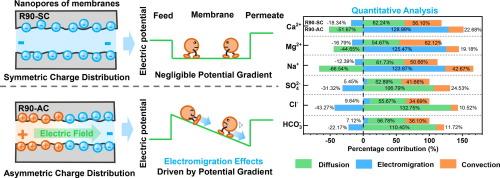非对称电荷分布的Janus纳滤膜中的离子传输机制:电荷梯度驱动的电迁移效应的定量分析
IF 11.6
1区 工程技术
Q1 ENGINEERING, MULTIDISCIPLINARY
引用次数: 0
摘要
干旱地区日益严重的淡水短缺需要先进的海水淡化和资源回收技术,以解决微咸水对农业、饮用水和生态系统的威胁。电荷不对称Janus纳滤(NF)膜在微咸水处理中显示出巨大的资源回收潜力,特别是实现高效的离子选择性分离。然而,目前的模型仍然局限于对Janus膜中离子传输机制的定性推测,因为它们未能纳入轴向电荷非均质性的定量描述。在这里,我们通过将轴向电荷分布集成到具有介电排斥(DSPM-DE)的Donnan立体孔隙模型中来解决这一差距。在商用纳滤膜(R90-SC)上涂覆带正电的聚电解质层,制备了电荷不对称Janus膜(R90-AC)。轴向电荷分布DSPM-DE模型将半咸水系统中6种离子的预测偏差降低至8%,优于传统模型(偏差16%)。理论模拟表明,在Janus结构中存在18.87 mV·μm−1的本征电场,导致阳离子的异常电迁移贡献超过100%,阴离子的异常电迁移贡献超过- 50%至- 20%。实验证实了这种“静电二极管”效应,Mg2+正向通量(2.69 × 10−2 mol·m−2·h−1)超过反向通量(2.98 × 10−3 mol·m−2·h−1)近一个数量级。该研究将理论建模与实际结构设计相结合,为离子选择性分离中调整电荷不对称结构提供了一个强大的框架。本文章由计算机程序翻译,如有差异,请以英文原文为准。

Ion Transport Mechanisms in Janus Nanofiltration Membranes with Asymmetric Charge Distribution: Quantitative Analysis of Electromigration Effects Driven by Charge Gradients
Rising freshwater scarcity in arid regions requires advanced desalination and resource recovery technologies to address brackish water threats to agriculture, drinking water, and ecosystems. Charge-asymmetric Janus nanofiltration (NF) membranes demonstrate significant potential for resource recovery in brackish water treatment, particularly enabling efficient ion-selective separation. However, current models remain limited to qualitative speculation regarding the ion transport mechanisms in Janus membranes, as they fail to incorporate quantitative descriptions of axial charge heterogeneity. Herein, we address this gap by integrating axial charge distribution into the Donnan Steric Pore Model with Dielectric Exclusion (DSPM-DE). A charge-asymmetric Janus membrane (R90-AC) was fabricated by coating a positively charged polyelectrolyte layer onto a commercial NF membrane (R90-SC). The axial-charge-distributed DSPM-DE model reduced prediction deviations for six ions in brackish water systems to < 8%, outperforming conventional models (deviations > 16%). Theoretical simulations revealed an intrinsic electric field (18.87 mV·μm−1) within Janus structures, driving anomalous electromigration contributions exceeding 100% for cations and −50% to −20% for anions. This “electrostatic diode” effect was experimentally validated, with Mg2+ forward flux (2.69 × 10−2 mol·m−2·h−1) surpassing reverse flux (2.98 × 10−3 mol·m−2·h−1) by nearly an order of magnitude. The study bridges theoretical modeling and practical structure design, offering a robust framework for tailoring charge-asymmetric structures in ion-selective separations.
求助全文
通过发布文献求助,成功后即可免费获取论文全文。
去求助
来源期刊

Engineering
Environmental Science-Environmental Engineering
自引率
1.60%
发文量
335
审稿时长
35 days
期刊介绍:
Engineering, an international open-access journal initiated by the Chinese Academy of Engineering (CAE) in 2015, serves as a distinguished platform for disseminating cutting-edge advancements in engineering R&D, sharing major research outputs, and highlighting key achievements worldwide. The journal's objectives encompass reporting progress in engineering science, fostering discussions on hot topics, addressing areas of interest, challenges, and prospects in engineering development, while considering human and environmental well-being and ethics in engineering. It aims to inspire breakthroughs and innovations with profound economic and social significance, propelling them to advanced international standards and transforming them into a new productive force. Ultimately, this endeavor seeks to bring about positive changes globally, benefit humanity, and shape a new future.
 求助内容:
求助内容: 应助结果提醒方式:
应助结果提醒方式:


